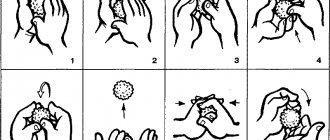Parents and teachers sometimes simply throw up their hands when they fail to teach their child to write correctly. It would seem that both the theoretical rules have been mastered and practice is constant, but no progress in mastering literacy is observed. The statistics are especially frightening. Most modern schoolchildren have problems with spelling and punctuation, not to mention the ability to structure text correctly.
How to sit down at a desk to write?
Every detail is important to achieve the desired result. How to teach a child to write correctly without mistakes and where to start learning? Sitting correctly at your workplace is the first step to mastering literacy:
- Teach your child to sit upright and not tilt his back back to the side.
- A child's fist should fit freely between the chest and the edge of the table, but the distance should not be large.
- The hand with which the baby writes can only be on the surface of the desk.
- You can tilt your head a little.
- The bending angle of the knees is only straight.
- Turn the bottom corner of the notebook towards the center of the chest at an angle of 45 degrees.
Teach your student to understand the rules
Let us emphasize: I did not cram, but taught with understanding. When reading the rules, it is important to remember a clear algorithm, why a certain word is written according to one point of the rule, and the second word - according to another. To do this, a parent does not have to be a teacher. It is enough to take an example from the rule and analyze it step by step, as is done in the explanation. Let’s say it’s difficult for a child to remember why the letter O must be written in the word “mountain.” To do this, the word needs to be checked by choosing a root word for it or putting it in another form so that the emphasis falls on O.
An explanation might look like this. We write the word on a piece of paper, highlight the root in it, emphasize the vowel O (spelling) and change the form of the word (gor-a - gor-y) or select the same root (gor-a - gor-n-y). So, all the conditions of the rule are met. You can begin to reinforce the example of other words so that you understand the rule. It is worth learning only the exceptions, and there are many of them in the Russian language.
Language is like a pyramid. Each of its bricks has its place. Without any component, the structure falls apart. Spelling is based on two pillars: the part of speech and the part of the word, and then it’s the choice of the rule. It is impossible to write correctly, based only on the sound of the word: RIDICULOUS and DEprivED, to stay at the dacha and to arrive at the dacha, pumped out barrel and pumped out oil.
Marina Semyonova, Russian language teacher at the Adukar educational center
How to distinguish a child's absent-mindedness from dysgraphia?
Often adults cannot understand that a child has serious problems with speech reproduction on paper. Even experienced teachers may mistakenly think that he is simply lazy. In fact, defining dysgraphia is not that difficult. You just need to take a closer look at the little student’s notes. Typically, errors with this deviation have their own distinctive features. You should contact a speech therapist if your child makes the following mistakes:
- Skips the same letters in words.
- In stressed syllables he makes mistakes with the spelling of vowels.
- Changes syllables in words.
- Doesn't complete words or comes up with extra endings.
- He writes some letters several times.
- He writes not letters, but their mirror image.
- Passes soft and hard signs.
- He writes without paying attention to the line.
- Regularly goes out into the fields.
- Forgets about capital letters and does not understand where to put periods.
- Doesn't understand how to pronounce words.
Principles of teaching children to write correctly
There are four basic principles for teaching children to write correctly:
- Create all the conditions for your child so that he can carefully complete tasks without haste or interference. If the computer or TV is on or music is playing, if there is loud talk in the apartment, the child simply will not be able to concentrate on learning.
- Keep your child's assignments under constant supervision. Check, work on mistakes, explain to your child how to write correctly. But when pointing out shortcomings, focus your child’s attention on how to do it right, and not on what he did wrong. For example, if a child wrote “dog”, immediately say that in a specific place you should write “o” and not “a”, without going into detail: “In the first syllable you need to write “o”, and in the second syllable “a” etc. This greatly tires and confuses children's thinking.
- Find some interesting stories for your child and get him used to reading for at least 5-10 minutes every day. While reading, he must correctly pronounce words syllable by syllable, studying their spelling. The correct options will be remembered automatically (by the way, Tikhomirov’s method is based on this idea, which we will talk about later).
- Regularly arrange dictations, for example, from the same stories that you selected for the child. It is recommended to carry them out 2-3 times a week. Errors should be highlighted with a red pencil so that the child can see them. It is also useful to write down problem words in separate vocabulary blocks that you create for your child so that he reads and remembers the words where he often makes mistakes.
These principles are very easy to follow. For this reason, some parents believe that they are not so important and that they can be done without them. However, later this will result in unlearned knowledge and many shortcomings in writing. So try to stick to them. And if we talk about ways to train competent writing, then one of the most effective is copying from a model and writing from dictation.
2
Who is prone to dysgraphia?
Are there risk groups? Everyone wants to know how to teach a child to write correctly without mistakes. But you should think about how to avoid the problem from a very young age. Parents should pay attention if:
- left-handed child;
- if the child was left-handed, but was retrained;
- in a family, parents speak different languages;
- if the baby has speech problems;
- with absent-minded attention;
- with difficulty remembering;
- if school starts earlier than expected;
- When writing, the child misses letters, confuses unvoiced consonants, and pronounces words incorrectly.
How to quickly teach a child to write dictations correctly: secret No. 5
Together with my mother, we learn to write dictations correctly.
The child must see the parents’ interest in his good results. If a child observes that mom and dad don’t care how he studies and what he does at school, then most likely such a child will not achieve high results. The game, which will be described below, will help teach Russian grammar to fourth and fifth graders.
Secret #5: Mutual verification
- Sit with your child at different tables and dictate short texts to each other.
- Parents need to make a few mistakes on purpose.
- Then exchange written dictations with your child and check them for errors.
- If the child does not see the inaccuracies on his own , then you need to tell him how many words contain incorrectly written letters.
This game helps develop memory and attention. The child will better remember the spelling of words and will use commas and other punctuation marks correctly.
How can you help?
You should think about how to teach your child to write without errors as early as possible. Such a child needs a lot of attention both at school and at home. Only with a systematic approach can a positive result be achieved. Psychologists and speech therapists give several useful recommendations for parents:
- Carefully monitor what mistakes were made during the day. When doing homework, you can unobtrusively pronounce words correctly, thus repeating spellings.
- Try to instill in your child a love of reading. Well-read people make far fewer mistakes thanks to automatic memory. In the future, the child may not know the rules, but he must write properly.
- Pay attention to the words that your child encounters in everyday life. Signs, advertising, TV - emphasize the correct spelling of difficult words.
The most important rule is not to scold or criticize your child. It’s not his fault that he has such a problem, and if you lower your self-esteem, you can only achieve even greater regression. Parents are simply obliged, first of all, to work themselves, spare no time, and study the issue. There is a wide selection of specialized literature. For example, a series of books by Tatyana Vasilyevna Shklyarova can be very useful. Shklyarova tells how to teach a child to write without mistakes, she explains it easily and clearly.
How to quickly teach a child to write dictations correctly: secret No. 3
Learning to write dictations correctly
Everyone knows that writing and reading are closely related. If a person reads a lot, he will write correctly. Therefore, the next secret is related specifically to reading, but some nuances should be taken into account.
Secret #3: Reading out loud systematically
- Independent reading develops memory and attention. But you need to read out loud, as young children better perceive the information that they speak.
- Choose books that are interesting to your baby . But remember that the correct literary language is represented only by some classic writers: Tolstoy, Chekhov, Bunin, Turgenev.
- First, let the child read as he writes - syllable by syllable, pronouncing each letter. Then you can move on to reading as we speak.
- Reading by role is interesting, entertaining and will help you remember individual words better.
Teach your child to read every day for 30 minutes. This will help instill a love of reading and improve speaking and writing skills.
How to treat and correct dysgraphia?
Treatment of dysgraphia and disorphorgraphia should first of all be based on eliminating the causes of the disorders, and also include correct and timely correction of writing. It is imperative to consult a neurologist and speech therapist. If concomitant diseases are identified, it is necessary to undergo a rehabilitation course, which may consist of physical therapy and physiotherapy. All violations in the letter are corrected by a speech therapist. The developed methods allow:
- develop skills of visual discrimination of letters and symbols;
- teach the skills of analysis and synthesis of information, in other words, compare, contrast, identify patterns;
- develop visual and auditory memory;
- teach basic morphological principles;
- help the child pronounce sounds and understand phonetic processes;
- enrich your vocabulary;
- form coherent speech in a child.
Dysgraphia
Previously, children who constantly wrote with errors were not paid much attention, and grades were pulled to C grades. Today they are officially diagnosed with dysgraphia. Today, among primary school students in Russia, approximately 30% of students have this diagnosis.
Such children, despite knowing all the spelling rules, cannot apply them in practice. Let's look at what signs you can judge the presence of dysgraphia in your baby:
- regular omission of letters in words;
- systematic incorrect spelling of vowels in stressed syllables;
- rearrangement of syllables;
- lack of word endings;
- duplication of letters;
- mirror image of letters;
- the absence of a soft, hard sign in the child’s letter;
- leaving the fields;
- lack of even spelling of words;
- there are no periods in sentences, and capital letters;
- no spaces between words;
- incorrect transfers.
How can I help you
Parents can use these methods to solve the most common problems.
- To avoid missing letters, you need to write “magic dictations”. For this purpose, you will need to pronounce up to four words, and the child must pronounce them out loud, syllable by syllable. Now, instead of syllables, you need to draw dashes in your notebook. At the next stage, instead of dashes, we use dots, in the amount of letters in each word.
- If the words are not completely written, you can play “Image of a Word.” Say the word and ask the child to name a new one that begins with the last letter. You can also suggest naming from the penultimate or third from the end.
- If you have problems with vocabulary words, you can play the game “Funny Cartoon”. Invite your baby to close his eyes and imagine the objects that you will name. Your task is to pronounce vocabulary words. At this moment, some images may form. It is desirable that the words are somehow interconnected, and the child can create a whole associative line. Ask him to tell you everything he has imagined. Now you need the child to write from memory the words that have been deposited in his head.
How to prepare a child for school?
As a rule, problems with spelling are discovered in the first grade. If you are thinking about how to teach your child to write dictations without errors in a short time, 2nd grade is the right time to start working. Second grade is the period when children are faced with dictations. In higher grades, if a student does not master spelling, he will have problems on tests and therefore poor grades. Preparation for this important method of spell checking should begin gradually, in several stages:
- repeat already familiar spelling rules;
- constantly practice writing unfamiliar words;
- apply the rules in practice;
- take dictation at least a few short sentences a day;
- repeat the spelling of words in which mistakes were made;
- during dictation, pay attention to pauses;
- start writing only after the sentence has been read to the end.
How to quickly teach a child to write dictations correctly: secret No. 2
Learning to write dictations correctly
To learn how to write in calligraphic handwriting without errors and blots, you need to put in a lot of effort. Parents and school teaching staff must find an approach to the child. The following secret will help teach Russian grammar to a second and third grader. This method is also suitable for secondary school students.
Secret No. 2: Regularly writing dictations
- At first, this may seem like an unnecessary task, but two texts a week , written under dictation, are excellent results after 2-3 months.
- Be sure to sort out the mistakes and do the analysis with your child. Thanks to this, he will better remember the structure of word forms in which inaccuracies are allowed. Repeat complex words 2-3 times during dictation. It is even permissible to give hints if the child finds it difficult to write this or that word.
- While analyzing errors , repeat the rules that will help you remember the spelling of complex word forms. It is important to point out inaccuracies to your child. You can invite him to write down the misspelled word, spelling it correctly, and write this word for several lines. Thanks to this technique, the baby will think about where he made a mistake and remember the spelling of this word.
The graphic image of words, which is remembered by a person forever, is of great importance. Therefore, it is important to develop in a child the ability to memorize a word and not make mistakes in it.
Rules for writing dictations that a child should know
The question of how to teach a child to write dictations without errors in a short time may seem difficult, but it is not. Don't be afraid of difficulties. All you need is:
- Explain to the little student that the most important thing is not to rush.
- You shouldn't write when you need to listen.
- Don't write it off.
- When writing, you can mentally pronounce the word syllable by syllable.
- When the teacher reads for the second time, you need to carefully monitor what is written in the notebook.
- Re-read your work several times.
- Be patient with your child. It takes a lot of time for adults to achieve results, but for children, due to their age, it is much more difficult.
- Don't scold for bad grades.
- Praise even for minor successes.
- Try to compete with him. Sometimes you can give in, because trying to write better than an adult is the main interest of the baby. During such competitions, you can invite the child to find mistakes in his mother.
- Keep a special notebook for cheating. Let your daughter or son write down their favorite poems and excerpts from works.
- Monitor the child's attention - let him try not to be distracted by anything.
- If you take up dictations, you need to pronounce each word correctly and take reasonable pauses.
- Try writing visual dictations.
- Make sure your student pronounces what he writes.
- Do not overload the child.
- Develop hand motor skills.
- Walk more in the fresh air, even though this, at first glance, does not relate to the question of how to teach a child to write correctly without errors, but oxygen greatly helps the good functioning of the brain.
How to quickly teach a child to write dictations correctly: secret No. 4
Learning to write dictations correctly
Little children like to play. Even big girls and boys better remember some knowledge gained in the game. Therefore, we continue to reveal the secrets of successfully learning to write correctly.
Secret #4: Learning as a game
- For kids, you can make cards with words in which the child most often makes mistakes.
- Hang them above the table or play a game in which you first have to write a word, and then a card with it will appear. You can offer to pull out a card and explain the spelling of a particular word.
- It is better to offer older children to be a teacher for a while . Let your child imagine himself at school, but in the role of a teacher explaining a new spelling topic to his students. The child must also take a dictation, and mom or dad must write it, preferably correctly.
Thanks to this technique, the child will learn to write correctly, but this will take some time. Don't demand everything at once. The child should not develop an aversion to the learning process. It is important to instill a love of books and learning; only a positive attitude from teachers, parents and the child himself will help.
Tips for parents: how to teach your child to write without mistakes
The list of tips on how to teach your child to write correctly without mistakes is actually not that difficult to master. Patience and care for the baby will definitely help you get a good result.
We have already theoretically found out how to teach a child to write dictations without errors. But what practical tips and exercises exist for developing a child’s literacy? You can get an individual correction system from a speech therapist. Modern experts tell how you can teach a child to write carefully without making mistakes. By the way, ten years ago no one talked about the problem of dysgraphia.
Tikhomirov method
The method was based in the 19th century on the theory of the famous teacher and public education figure Dmitry Ivanovich Tikhomirov. The researcher believed that in order to teach a child to write correctly, it is necessary to force him to read the text exactly as it is written, without fear that the child will begin to speak in exactly the same way. Every child understands that people speak differently than they write.
In practice, this theory is implemented very simply - you need to teach the child orthographic reading, during which special attention is paid to the syllables of words. Give your child the task of reading a text out loud, clearly and loudly, but not the way people speak in everyday life, but syllable by syllable. You need to read at a fast pace, but manage to highlight and emphasize syllables.
With this reading, motor, auditory and visual memory is activated. As a result, when faced with already familiar words in the text, the child will mentally pronounce them correctly, and therefore write them too.
Among other things, Tikhomirov himself, and many teachers who have used and are using his method today, are confident that literacy through spelling reading is best taught using classical literature, for example, the works of A.P. Chekhov, A.N. Ostrovsky, A. From Griboyedov, A. S. Pushkin, I. A. Bunin and other authors.
And so that classes do not turn into “torment” for a child, you need to form his attitude towards them as an interesting game, because playing is much more interesting than studying. Spelling reading will be a pleasant pastime and fun, because words read syllable by syllable can sound very comical.
Up to 10 years of age, you can read with a child in this way for 10 minutes a day. If you have vocabulary blocks for your child, let him read them in the same way - syllable by syllable, clearly and loudly, and several times. When a child pronounces words not as they are written, but as they are spoken, you need to immediately pay attention to this and ask him to re-read.
According to D.I. Tikhomirov, daily systematic spelling reading classes contribute to the development of a child’s sense of natural literacy. After just a few months of lessons, children begin to write words without errors, even complex terms.
Using D.I. Tikhomirov’s method in the learning process in combination with writing from dictation and copying from a model, you will teach your child to write exactly as needed - without typos and mistakes. His vocabulary will also expand, which means that from the first years of education he will begin to show excellent results in lessons at school and in completing assignments at home. In fact, your child will grow, constantly developing and improving in the skills he has acquired.
Here we want to warn you: if the above methods do not work for some reason, then there may be two reasons: either you are conducting the classes incorrectly, and in this case only you can influence the situation, or the child has minor problems with phonetics - phonemic perception. In such cases, the child hears everything, but the abundance of merging sounds creates obstacles for him to comprehend the words. A consultation with a speech therapist will be a way out, because a specialist will always be able to choose an individual correction course. However, visiting a speech therapist will never be a bad idea, because... a professional can hear and see things that parents simply won’t pay attention to. By nipping at the roots of difficulties at the very beginning, you will create fertile ground for successful writing learning in the future.
In the next lesson, you will learn about literacy indicators for children of different ages, several interesting spelling exercises and games for solving problems with punctuation, you will become familiar with the principles of working on spelling and other information on what to do if a child writes illiterately.
Working with warped text
Offer your child scattered words from which you need to compose a coherent text. The level of difficulty must correspond to the age of the child. Offer to independently reconstruct the text that lacks the necessary words. Or a text in which only the last words are missing. With the help of such simple exercises, the child will easily master the basic rules of syntax in practice.
After such exercises, the question of how to teach a child to write without mistakes no longer seems so difficult.
Learning to write without errors
Tips for elementary school students and their parents
The right motivation
The child must understand why he needs competent writing. A person who writes and speaks competently always commands respect from others. Moreover, these skills will definitely come in handy in business life. And a regular SMS message is more pleasant to read when it does not contain grammatical errors.
Game-based learning
As we have already said, it is easier for a preschooler, as well as a primary school student, to remember material if it is presented in a playful way. The following games will be useful:
1. Find and label
The child is offered a text in which, for example, the letter “l” must be circled and the letter “a” crossed out.
2. Echo
An adult reads the word. The child’s task is to reproduce the ending of this word. Then write it in your notebook and highlight the ending with a special sign.
3. Find the word
The child is presented with a text in which he needs to find a word based on certain characteristics. For example, all words starting with the letter “s” or all words ending with the letter “a”.
4. Make up a word
Mom or dad lay out cards with letters in front of the child. The child’s task is to make a word out of them. It’s better to start with simple words: “house”, “garden”, then move on to more complex ones: “hello”, “desk”, “chest of drawers”, etc. If a child finds it difficult to complete a task, he is given only the letters that make up the required word. word.
You can complicate the game: make up the name of your favorite fruit or sweet from letters. In this case, the child chooses the word himself.
These and other games will help schoolchildren learn to write even the most complex words carefully and without errors.
Don't forget about physiology
There is no need to force your child to sit at the table for hours and achieve even calligraphic handwriting. Otherwise, classes will turn into torture for him. 20-30 minutes a day devoted to the development of competent writing is quite enough for a primary school student.
Also find out what to do if your child does not want to study and do his homework.
How to help a middle school child?
If a child has not developed the skill of writing correctly after elementary school, then it is necessary to continue this work in the middle grades.
The following exercises will help students:
Find the mistake
The parent composes a text with errors in those words whose spelling the child cannot remember. The child’s task is to find the misspelled word and remember the rule that should be followed when writing this word.
Dictionary of difficult words
It is necessary for recording vocabulary words and words in which the child constantly makes mistakes. An adult dictates words from it first, and then sentences with these words, checking the correct spelling.
Life hack: find the right motivation for your student’s learning. Together, come up with a desired goal for which the child will save by completing certain tasks from the parent. The “Where are my children” application and the new “Children’s Tasks” feature help you do this!
Make a proposal
The child is offered cards with words, from which he must make a sentence and write it down in a notebook. An adult checks the correct spelling of words and the literacy of the text.
Missing words
The child selects words that are missing in meaning. For example: “In the spring it melts…., they run…., they fly in from the south….”
Make up a word
The same exercise as for younger grades, but using more complex words. For example, terms from any field (recycling, abbreviation, dissimilation and others).
What is a language card?
To track the progress and dynamics of changes in literacy, there is a special method for recording results. A language map is a way to record all results and changes. By writing everything down, you can comprehensively monitor how the process is going and what needs to be changed in the adjustment methods. The language card includes:
- disturbances in oral and written speech;
- ability to pronounce and distinguish sounds;
- analyze and synthesize parts of a word;
- reading and writing skills.
By regularly filling out the card, you will clearly see what you have achieved and how long it took to achieve results in solving the question of how to teach a child to write without errors.
Getting ready for the dictation
When there is work to be done at school to test a child’s spelling knowledge, it is necessary to prepare for it, taking into account the following sequence:
- review all the rules we have learned;
- we put them into practice through training;
- mother dictates a small fragment of literary text, allocating a certain period of time for it;
- in writing we repeat the spelling of dictionary words;
- We carefully check what is written.
We write excellently
In order for a child to write high-quality dictations, it is necessary to follow certain rules:
- when the teacher reads a sentence, you need to pay special attention to punctuation marks;
- reproduce in writing what you heard only after the teacher finishes the sentence;
- there is no point in writing ahead of time;
- no need to peek at your neighbor’s notebook;
- when you write a word, mentally read it syllable by syllable;
- do not forget to re-check what you have written when the teacher reads the entire text again;
- When you re-read it, mentally reproduce the words syllable by syllable.
Ways and recommendations to teach your child to write beautifully
At the beginning of their education, children experience enormous physical and emotional stress when writing assignments in copybooks or notebooks. The situation is complicated by children's low endurance to static loads. What will help a child learn to write beautifully?
Make sure your child is positioned correctly at the table
Incorrect position of the body, hands or notebook not only negatively affects handwriting, but also leads to severe muscle fatigue and the formation of incorrect posture
Select a suitable writing instrument: the optimal length of a pen or pencil is 15 cm, the optimal diameter (thickness) is 5-7 mm, it is preferable to have a rubberized pad on the body in the place where the child holds the pen to prevent fingers from slipping. Pay attention to the correct grip of the writing instrument with your fingers - this will avoid overexertion and muscle spasms and develop beautiful handwriting
Handles with rubberized indentations for the thumb and forefinger help ensure proper grip. These pens are available for right-handers and left-handers.
Special training attachments will help your child learn to hold a writing instrument correctly
Work on mistakes
Often at school, teachers require work on mistakes, for example, to correctly write the word that the child misspelled several times or even lines. This method can also be used by parents. You can ask the child to spell out the word that caused difficulties, and then write it down in the correct version. You can also make learning cards yourself, on which you can write or print words that are difficult for your child, with a space in the problem area. Have the child write in the missing letter with a pencil. Or you can offer to choose those cards in which the same letters are missing. Thanks to this kind of work, children will pay more attention to dictations and try to write correctly right away, so that they don’t have to work on mistakes later.
Of course, all these tips are good in conjunction with memorizing the rules of the Russian language. If you see that the child has gaps in the material covered or the mistakes are of the same type, then you need to repeat the grammar and rules.
Undoubtedly, parents' creativity, praise, interest and effort will bring good results in a child's literacy education.
At what age should you pay attention to literacy?
How happy parents are when the baby begins to babble the first words, and then his speech becomes more and more understandable and meaningful. Then mothers and fathers begin to teach the baby to write. And do it without errors. However, this is a serious miscalculation of parents - the time must come to teach competent writing. Scientists have found that the formation of literacy levels is almost completely completed by the 4th grade. That is, you need to work with your child to improve the level of spelling most intensively from 2nd to 4th grade. Next, there is an increase in knowledge about the language, which falls on the already established information soil formed at the initial level.
Please note that if it is impossible for a child to learn to spell, dysgraphia should be excluded - a violation of the principle of writing in the normal development of intelligence. This disease is usually accompanied by speech disorders and some mental disorders.
This is interesting. According to a nationwide study of literacy levels in the country, 70% of schoolchildren make more than 4 mistakes when writing dictations.
What is dictation
Dictations can be control or thematic.
With the help of tests, knowledge of the material is tested and final grades are given. Thematic dictations are carried out after studying a specific topic in order to consolidate knowledge in practice.
During the educational dictation, the teacher explains the spelling of difficult words and the placement of punctuation marks.
He can also do this after dictating the text, discussing with the students the difficulties in understanding the spelling of individual words or sentences.
It's not just children who write dictations. In Russia and Ukraine there is a tradition of holding nationwide dictations. People of different ages and professions participate in this event. In Ukraine, this event is held on November 9, the Day of Ukrainian Literature and Language.
Many strict parents may be interested in the information that out of thousands of participants, only a few write the text without errors. Thus, in Ukraine in 2010, three out of eleven thousand participants wrote a paper without a single error.











